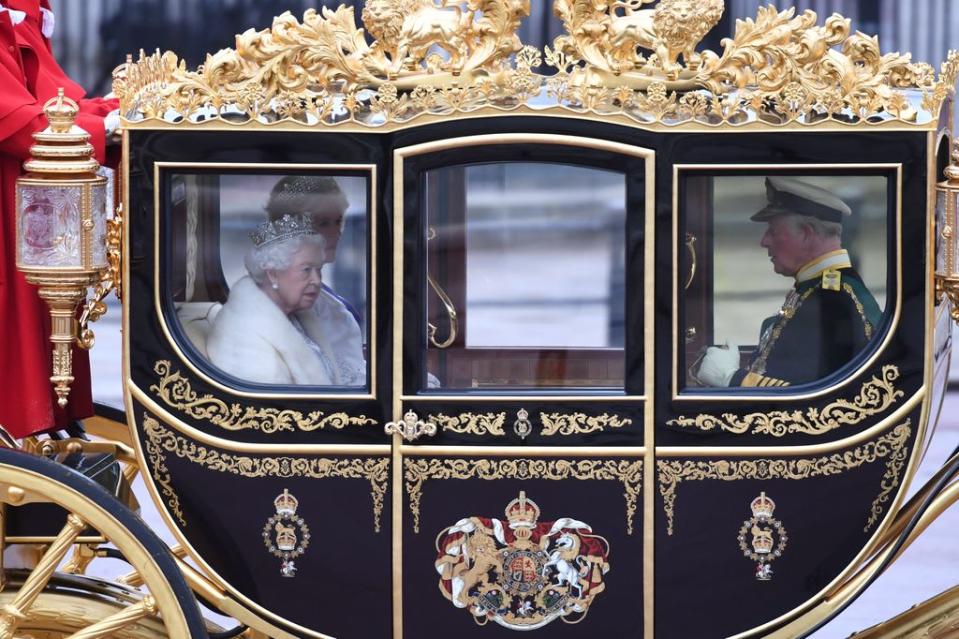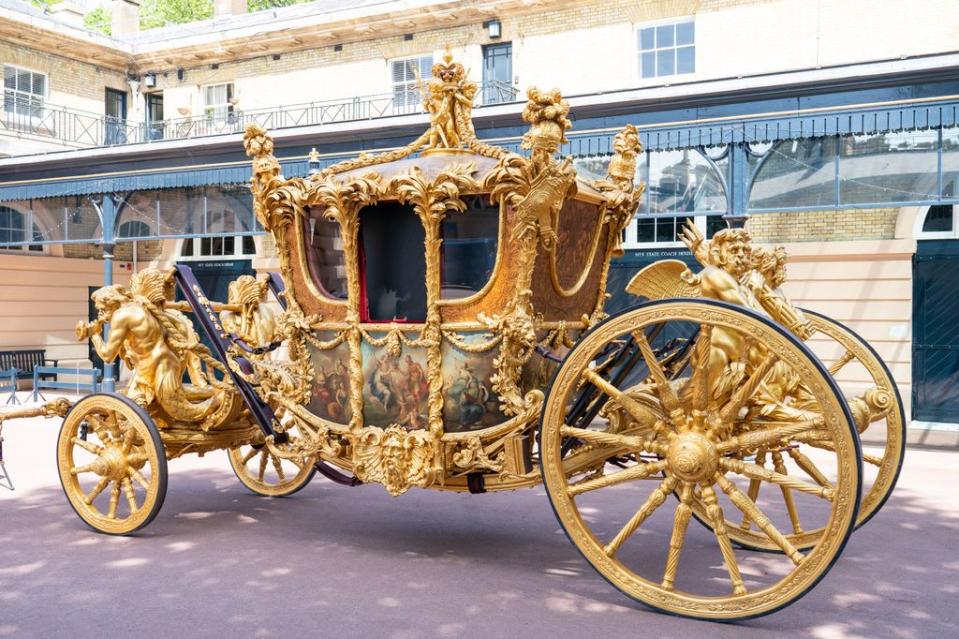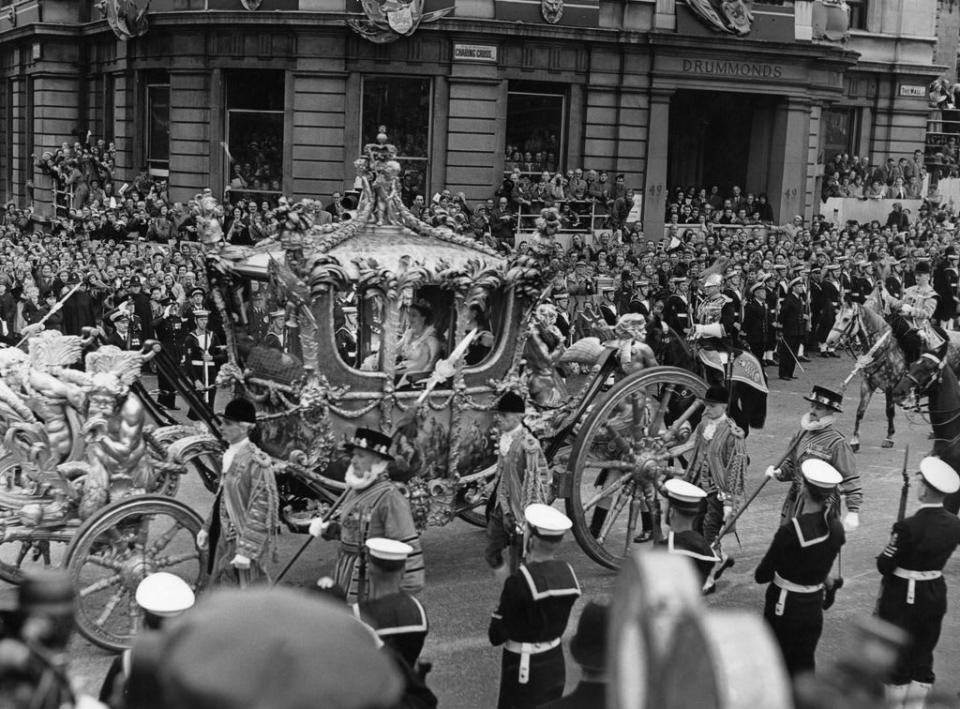The King and Queen Consort's coronation carriages and procession route confirmed by palace
The King and Queen Consort will be carried from their coronation at Westminster Abbey in the historic Gold State Coach last seen during the late Queen's Platinum Jubilee pageant, Buckingham Palace has confirmed.
In a dazzling display of pomp and splendour, the royal couple will depart the ceremony in the 253-year-old horse-drawn carriage, which has leather straps for suspension and is famously uncomfortable to ride in.
In a 2018 interview, the late Queen described riding to and from her own coronation in it as "horrible" and "not very comfortable".
But the royal couple have decided to stick with tradition for one of their two spectacular coronation day processions at least.
The Diamond State Carriage
Their Majesties will instead travel to the Abbey in the Australian-built Diamond State Coach, which was made in 2014 and boasts comfortable seats, shock absorbers and air conditioning.
The smaller carriage will reflect a smaller arrival procession at the Abbey, according to royal aides.
Built for Queen Elizabeth II's 80th birthday, the Diamond Jubilee State Carriage features a crown on the roof made from wood taken from Admiral Nelson's flagship HMS Victory.
READ MORE: How King Charles III's coronation will differ to Queen Elizabeth II's

The interior, which is decorated in primrose yellow silk, contains a fragment of a dress worn by Florence Nightingale and wood taken from major British landmarks, including St Paul's Cathedral and St George's Chapel at Windsor Castle.
Speaking at the Royal Mews at Buckingham Palace Sally Goodsir, Curator of Decorative Arts at The Royal Collection Trust, said: "It's a real microcosm of British and world history.
"The interior is inlaid with specimen woods from places such as Balmoral Castle, Osborne House on the Isle of Wight, the Palace of Holyroodhouse in Edinburgh, but also from places deeply associated with British and world history, there is a fragment of Florence Nightingale's dress for example."
The King has travelled in it before when he sat with his mother for the 2019 State Opening of Parliament.
The Gold State Coach
The Gold State Carriage, which can only carry a Sovereign and Consort, will take Charles and Camilla from the Abbey to the Palace.
Sally said: "This is going to be the centrepiece of a much larger and longer procession from Westminster Abbey back to Buckingham Palace on coronation day.
"It is huge. It is four metres tall and seven metres long and weighs four tonnes. Because of that it can only move at a walking pace which really adds to the majesty and stateliness of this great royal procession.
"There are eight horses required to pull this carriage, which adds more of course to its length. When it passes you in the street you will just have this glimpse of gold with the Sovereign travelling inside."
SHOP: King Charles III coronation memorabilia: From mugs to tea towels, ornaments & more

The gilded wooden coach was built in 1762 and is only ever used to convey a monarch and their consort.
Sally added: "There are very few monarchies which have retained working coaches of this age and therefore it's an incredibly special thing to see, really harking back to a couple of centuries earlier, a world we probably can't imagine today of carriages, horses on the streets."
Coach restorer Martin Oates, 57, is the brake man on the Gold State Carriage, a role he took on from his father.
He is now in his 40th year of working at the Royal Mews, following in the footsteps of his grandfather and great grandfather who both rode in Queen Elizabeth II’s Coronation procession in 1953.
Martin's father Alfred rode postillion for the Gold State Coach for the 1977 Silver Jubilee and Martin walked behind the coach in procession during the Golden and Platinum Jubilees. He will do so again in the 2023 coronation procession.
He said: "The point of the brakeman is to make sure the carriage does not roll backwards and forwards. To stop the carriage rolling backwards at the Abbey I put the brake on, that is the plan. It's not tricky but it is quite a big vehicle and horses don't always stop when they are meant to.”
Speaking about efforts to improve the comfort, Martin said the leather suspension straps were changed 15 years ago.
He said: "We have changed the straps on it and feel it will be a lot more comfortable."
Comparing the two carriages, he said: "The Diamond Jubilee State coach has shock absorbers on and is much like a car. This has suspension on leather straps. When you follow it, you hear it creaking, it is like an old galleon. Whereas other vehicles move back to front, this also moves side to side."
Royal tradition
The vast Gold State Coach can only leave its home in the Royal Mews by taking out a removable wall and window.
The King's Head Coachman Matthew Powers, 35, is in charge of safety for the historic vehicle on coronation day.

He said: "It is quite some task. We have eight horses. We are there to make sure the King gets there safely and returns safely. This coach went out last year, so we are using the same horses and we know they have done it before, but have not had the added pressure of taking His Majesty the King in it. But the horses can take the crowds. We know they can pull the vehicle and have worked together as a team.”
Matthew added: "His Majesty is very much interested in everything we do here and it was his decision to take the vehicles he has chosen to use. The King is happy to stick with tradition."
Take a look at all of the ancient coronation rituals and traditions in the video below...
The coronation procession route
The King’s Procession, accompanied by The Sovereign’s Escort of the Household Cavalry, will depart Buckingham Palace through the Centre Gate, and proceed down The Mall, passing through Admiralty Arch and along the south side of Trafalgar Square, down Whitehall and along Parliament Street.
The King’s Procession will travel around the east and south sides of Parliament Square to Broad Sanctuary to arrive at the Sanctuary of Westminster Abbey, where the coronation service will begin at 11 o'clock.
The procession from Westminster Abbey to Buckingham Palace, the Coronation Procession, will be much larger in scale, taking the same route in reverse.
The Coronation Procession will include Armed Forces from across the Commonwealth and the British Overseas Territories, and all Services of the Armed Forces of the United Kingdom, alongside The Sovereign’s Bodyguard and Royal Watermen.
Their Majesties will travel in the Gold State Coach. The coach, last seen during the Pageant of the Platinum Jubilee of Queen Elizabeth II in June 2022, was commissioned in 1760 and was first used by King George III, to travel to the State Opening of Parliament in 1762. The coach has been used at every Coronation since that of William IV in 1831. The coach will be drawn by eight Windsor Greys and, due to its weight of four tonnes, will travel at walking pace.
LISTEN: Want to hear more about the royal family? Check out the best of 'A Right Royal Podcast'
Make sure you never miss a royal story! Sign up to The Royal Explainer newsletter to receive your weekly dose of royal features and other exclusive content straight to your inbox.



